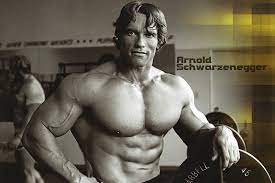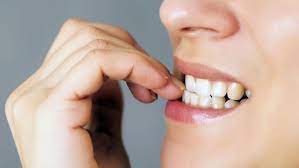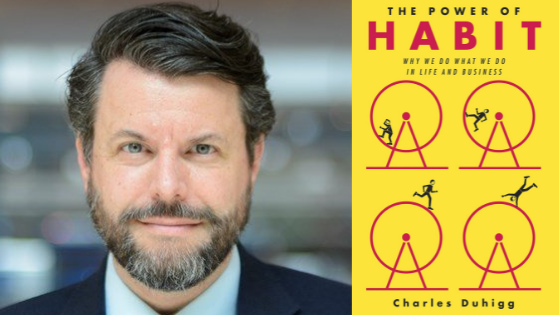Habits are in vogue right now. The are being offered as the cure-all to everything– lack of motivation, conflicting goals, laziness. Simply turn your behaviors into habits, the argument goes, and you’ll no longer need effort, goals, or motivation. They are the key to persistent action. The problem is, the science doesn’t support this position. And as you’ll see, neither does common experience.
(1) Arnold Schwartzenegger, Meditation, and Why Habits Don’t Persist

I find it reassuring to know that even The Terminator can feel overwhelmed.
In the 1970s, still only in his 20s, Arnold Schwartzenegger had already begun his quick climb to stardom. Most know about the body building and Pumping Iron— the documentary that filmed Arnold training for his record 6th Mr Olympia title. But you might not be aware that Arnold made his first million dollars, not from lifting weights or film, but in real estate. Throw on top of that a construction business, mail-order merchandise, and evening acting classes. That’s quite a load. And at some point, it caught up with him.
“A lot of things came together at once,” he told Adam Bornstein[1]. “I was overloaded.” Arnold told Bornstein that he was having trouble concentrating on any one project at any one time. While he was working out, he couldn’t keep his mind off of real estate; while he was working on real estate, his mind would wander to acting. Finally, Arnold decided to seek help.
Eventually, a friend told him about transcendental meditation (“TM”). TM, just like any meditation, is about trying to gently focus your mind on something: your breath, an object, your body, or in the case of TM, a ‘mantra’— a phrase you repeat in your head. TM has a pretty star-studded track record. Helping everyone from financier Ray Dalio, to Jerry Seinfeld, to the Beatles, it seems like an obvious play.
But there’s one catch to TM— it’s hard.
It’s not necessarily hard in theory— just repeat something in your head and focus your attention on it. It’s hard in practice. As the philosopher Blaise Pascal said, “all of humanity’s problems stem from man’s inability to sit quietly in a room alone.” But, just like maintaining a healthy diet or writing everyday, the most difficult part of TM is not beginning, but maintaining—continuing to do it over and over once the novelty of a new challenge has worn off.
To overcome such a hurdle, everyone from social scientists to entrepreneurs seem to advise the same exact strategy— make it a habit. To meditate everyday, in the same exact way (your on your living room chair), at the same time (7AM). Keep this pattern up— wake up, go to living room, meditate, repeat— and, after a few months, it will become automatic. Habits, it would seem, must be the key to bulletproofing behaviors.
For Arnold, doing something hard over and over for days, months, or years, was already common practice. So he, more or less, already understood the habit model, at least intuitively[2]. And he took to TM with similar consistency. “I did 20 minutes in the morning and 20 minutes at night,” Arnold said in an interview[3]. Every single day— for a year.
The more Arnold practiced, the easier it became. Eventually, it became so easy, that it just happened— no decision, little effort. It was just like the habit gurus had said. And, after just a few months, he’d done it—created an impulse to act from frequent repetition in the same context. In other words, he’d created his TM habit.
To his surprise and relief, TM actually worked. Arnold learned to focus, how to ease his mind. “All of a sudden, I could focus on one thing. I could do real estate and not be thinking about bodybuilding. When training, I wasn’t thinking about acting.”[4] That was surprising, but what was much more surprising is what Arnold did next.
At the end of that year of building a life-changing meditation habit– after doing it so regularly, and so similarly, that it became integrated into his brain– what did he do?
He stopped. He quit cold turkey. And he hasn’t looked back in 40 years.
*
THIS SUDDEN DITCHING OF TM brings to mind a question. And that question gets to the heart of this article— about why habits aren’t as sticky as their cracked up to be. About how and why habits fail.
The popular impression of habits is that they are resilient. Like a rotisserie chicken—something that we can simply ‘set and forget.’[5] The key advantage to a habit, theoretically, is that once built, they’re hard to break. The behavior becomes automatic, unconscious. It decouples from decision, intention and goals so that you no longer need to muster motivation. The entire point of Arnold making TM a habit, was so that he didn’t have to ‘get himself to do it’ everyday. It would simply happen.
But here’s what’s puzzling: if habits are automatic—If they become completely separated from conscious decision—how did Arnold just drop TM once his goal was met? One of the leading habit researchers in the world, Wendy Wood, says “that it’s habit that creates persistence.” But Arnie just discarded TM after it served its purpose, like it was last month’s issue of Men’s Health. I’ve had rug burns more persistent than that.
But wait a second, you might object—Arnold wanted to give up TM. The reason habit is so powerful is that if you want to keep it, it lasts. If you’d rather leave it to the side, that doesn’t disprove habit.
It’s a reasonable objection. That the idea of habit is not for keeping something that you don’t want, but to automate a hard-to-do action you desire. Reasonable, but wrong.
Habit is supposed to be wholly distinct from ‘what you want’. The point is doing them even when you lack motivation. Wood is explicit about this, writing that habit is “automaticity in lieu of conscious motivation.” No ‘want’ required.
If that’s true, it shouldn’t matter that Arnold no longer wanted to do it. Just like hitting snooze on the alarm, or checking your email whenever you pick up your phone, they happen without desire, or even thought. Which means stopping them should be no easy task— even when you want to.
*
But you may have picked up on a difference.
One the one hand, habits like meditation or going to the gym are ‘good.’ While the impulse to check email or hit snooze work against your interest. Standford’s BJ Fogg makes this point clear.
Fogg distinguishes between the two types of habits like this[6]. The ‘good’ habits, like swimming laps every morning, or skipping the cookie butter at Trader Joes[7], Fogg calls ‘uphill habits.’ These habits, like Arnold’s TM, are hard to maintain, but easy to stop. On the other hand, habitual handfuls of popcorn at the movies, and repeatedly watching Jim Carey YouTube clips[8], Fogg calls ‘downhill habits.’ These are the ones that are easily picked up, seemingly impossible to drop.
But while Fogg acknowledges this difference, he doesn’t offer much more. Are both Uphill and Downhill Habits the same thing? Does motivation matter more when you’re running Uphill? And what are the implications for the ‘persistence’ of habit?
To investigate this theory, let us contemplate the last 18 months. I’m referring, of course, to everyone’s favorite virus— COVID-19.
(2) Why Your Habits Got COVID (And How To Stop Biting Your Nails)

ONE OF THE MOST FASCINATING ASPECTS of 2020, was how many rock-solid habits so easily crumbled.
Long-time exercisers, unable to go to gyms or group classes, stopped exercising[9]. Everyday writers, separated from their coffee shops and matcha lattes, stopped writing. Celebrities who had remained sober for decades, relapsed. These ‘automated’ behaviors, you’ll recall, were meant to be immune to outside forces.
Notice, the above habits are all ‘Uphill’— hard to pick up, easy to drop. But the same happened with the Downhillers.
For me, the most surprising Downhill habit that COVID infected was the particularly gross habit I’ve had the pleasure of having my entire life— nail-biting. An oddly large amount of people dropped their lifelong, nail-biting habit during COVID. Writer Shane Parrish and my hair dresser[10], are two random examples. Despite the fact that they didn’t desire to bite their nails at any point in their lives, they did anyway. Why? Because it was a habit, and habits, we are told, do not succumb to desire— they are subconscious.
But during COVID, something changed. Perhaps fearing that everything they touched was virus-packed (and therefore potentially deadly), they stopped placing their virusy fingers in their mouths. They felt the same old urges— the habitual impulses— to start nervously chowing down, but they seemed to override them. Note that in the habit universe, this act— consciously dropping a Downhill habit—is otherworldly.
Is it possible, then, that for a motivation compelling enough— such as getting infected with a deadly disease— people will change apparently ‘automatic’ behaviors? That even a lifelong bad habit can be neutralized? Not only is it possible. But it has been raised by several habit experts— these from across the pond.
Benjamin Gardner, a leading researcher out of London, has proposed this exact, counter-culture explanation in recent papers.[11] In fact, Dr. Gardner has challenged the entire scope of habit theory and its—according to Gardner’s analysis— slim evidence.
“Fundamental theoretical predictions that, in unchanging contexts, habits will remain stable over time, consistently prompt behavior, and override conscious deliberative tendencies, have not been adequately tested,” Dr. Gardner wrote in a 2015 review of the existing evidence. “Little empirical attention has been paid to the sustainability of habit over time.” [Emphasis mine].
In other words, the idea that habits are the key to longevity is not only highly theoretical, but wholly questionable.
Back to COVID.
The silver lining in all of this is the other side of the coin. Even more interesting than those suddenly fickle, ex-habiters, were the people who, despite the extreme change in context, goal, or motivation, maintained their exercise, gratitude journals, and doing the dishes. Even if the shock of the first weeks of quarantine were enough to rattle their habits, these committed few, resolved to, ditch their pajama pants and once again, reinstate their ‘better selves.’ They got back to work.
But how did they do this? Was there something different about the people who adapted? Do they have better DNA? Did they have stronger habits to begin with? Or was there something else going on?
If you posed that line of questioning to a particular, Pulitzer-prize winning journalist, he’d probably say the latter.
(3) Duhigg’s Third Conclusion: The Limit of Habit

For the last decade, you couldn’t walk into a book store, a self-help seminar, or look at the best-seller list without being bombarded by habit.
Search Amazon for ‘habit’ and thousands of results pop up. We have Tiny Habits, Mini Habits, and Atomic Habits. There’s the habit everything. The Coaching Habit, Success Habits, Million Dollar Habits, even Magical Habits. And, for those looking for a little more edge with their routines— Badass Habits.
If you’re looking for someone to blame, there’s probably no single person more responsible for this habit mania than Charles Duhigg, and his mega-bestseller, The Power of Habit.
In 2004, while on assignment Baghdad for the New York Times, Charles Duhigg, found something surprising. He observed that military commanders, rather than teaching complex behaviors to cadets, would focus as much as possible on teaching a collection of small habits— simple actions that, through repetition, become automatic. And that all of these simple habits eventually produced an army capable of full-scale war. Duhigg was fascinated.
For the next 4 years, Duhigg researched everything he could about habit— he interviewed some of the top behavioral scientists in the world and poured over the research. He also talked to some of the top practitioners of habit, from the NFL to Alcoholics Anonymous. The product of this research was Duhigg’s book, The Power of Habit.
The Power of Habit offers three distinct conclusions about habits. The first two conclusions have been at the heart of the habit craze. Everyone seems to cite them, praise them, live by them. What’s odd, however, is that most people ignored the third conclusion.
Which is a shame, because it’s the most important point that Duhigg had to offer.
*
THE FIRST OF Duhigg’s conclusions can be a little unsettling: half of our lives are run, not by conscious, deliberate choice, but by a collection of unconscious behaviors called habits. That many of the activities we perform (brushing our teeth, tying shoes, showering), we do not do by choice, but by conditioned responses to a specific sets of circumstances—a process known to researchers as “the habit loop” (explained below).
For 50% of our lives, in other words, we are not much more evolved then Pavlov’s salivating dogs. The power of habit, thought of in this light can be jarring. Concepts that suggest we lack control over our actions tend to lead our minds down a thorny path.
Fortunately, Duhigg rescues us with his second, far more optimistic, finding.
The second conclusion was that we have the ability step in. That on a daily, weekly, and yearly basis, we have the power—the responsibility— to direct our automatic actions along the lines of our intentions. To be clear, conclusion #1 still holds— they are still automatic. Like breathing or balance, they are performed subconsciously. However—and this is the crucial part— we decide on their direction, their character, and their duration. From making our beds, to performing athletic feats, to improving at work, we can sub in fulfilling, productive habits on the way to our goals.
These first two conclusions represent the power of habit. They make mastering habit seem like the road to success. And not just any road— they make success seem somehow easier and within reach. That once you establish these good, albeit Uphill habits, they will take you to the Promised Land. Which probably explains why everyone from bloggers to coaches to academics have jumped on the bandwagon.
“There’s no debating or decision,” James Clear wrote, on the benefit of trading motivation for habit. “Lack of motivation doesn’t matter. You just follow the pattern.”
“Wouldn’t it be helpful if all of us carried around the tools to build our own anti-stress refuge… the kind of behaviors that achieve long-term goals?” Researcher, Wendy Wood asks rhetorically. “Actually, you already have that. Habits are those safe harbors.”
“We are what we repeatedly do,” Aristotle said. “Excellence, then, is not an act, but a habit.” And if Aristotle says it, you know it’s gotta be true[12].
But, there’s something too-good-to-be-true here, isn’t there?
Don’t you know plenty of people who, like Arnold or Shane Parrish, have picked up habits (cook at home or run in the morning) and held onto them for long periods of time (months to years), but also like Arnold or Shane Parrish, have since stopped? I know I do.[13]
According to the theory, habits are meant to continue despite waning motivation, changing desires, or flagging self-control. And yet, real-life evidence seems to be lacking. In fact, as Dr. Gardner shows, if you look at most of the foundational habit studies— they are underwhelming when it comes to questions of longevity and consistency.[14]
My argument is this: based on evidence, example, and common sense, the case for habit, and its supposed durability, is theoretical at best, wrong at worst. That for all the hype about habits and their power, they reliably dissolve in particular circumstances.
Don’t get me wrong—habits are powerful.
To the extent that you can identify behaviors you’d like to make consistent (running three miles per day, for instance), and then make them so consistent, that they begin to seem effortless, maybe even (at least metaphorically) automatic, obviously that’s an advantage.
But the habit pendulum, it is clear to me, has swung far afield. When you peer under the hood, habits are not as much the silver bullet, but rather, one useful arrow in the quiver. One tool in the long-term behavioral change package, not a panacea you simply ‘set and forget.’
The goal, then, is to recognize this overcast, and then, to point to these other evidence-based tools we need for long-term change. To achieve true endurance, the science suggests, not only will we need to supplement habit with an array of other behavioral changes, but we will have to reassess, restructure, and reinforce these changes, again and again.
When the stock market climbs to unusual heights in response to, in Greenspan’s[15] words, an ‘irrational exuberance,’ financial experts anticipate what’s called a ‘correction.’ A regression back to the norm. The norm is ‘corrected’ in accordance with the market’s actual value, rather than the bloated expectation.
This article is a habit correction.
__
HERE’S THE THING, THOUGH— I’m not the first person to point this out. It was all there in Duhigg’s best-seller nearly a decade ago. His three conclusions.
You know the first two: (1) about 50% of our lives are run on the habit loop and (2) we can step in, decide which habits we want, and redirect our behavior. That’s the power of habit.
But the third conclusion was different. It wasn’t about the power of habit at all, but the opposite— its inherent limits. About how and when habits fail.
It turns out, in other words, that the vaunted Habit Loop has some holes. Loopholes.
***
I’ll get to those loopholes and what to do about them in Part 2.
[1] By the way, Bornstein is a great resource for fitness and nutrition (his website). I first discovered him through his collaborative book with John Romaniello— Engineering the Alpha. Despite the bro-ish title, he (and Roman) are two thoughtful, balanced guys, and there’s a lot of wisdom in their writing.
[2] See: 5 hours per day in the gym
[3] From the Tim Ferriss podcast
[4] Interview with fitness writer, Adam Bornstein (Great interview in full).
[5] I am, of course, referencing the rotisserie oven infomercial. BTW, the best article ever written about Popeil, who unfortunately passed recently, was Malcolm Gladwell’s New Yorker article in 2000.
[6] Referenced in Fogg’s book, Tiny Habits
[7] Man, that’s good.
[8] Yes, it’s a weakness, people.
[9] Study: “A Pandemic Within The Pandemic: Physical Activity Levels Substantially Decreased in Countries Affected by COVID-19″
[10] I have no idea what to call a female cutter of a male’s hair. Barber doesn’t sound right. Neither does hair dresser or stylist. Please help.
[11] Study: https://www.ncbi.nlm.nih.gov/pmc/articles/PMC4566897/
[12] Aristoteleans, don’t freak out. I’m heavy Into the peripatetic master, and indeed, I discuss the Golden Mean and some other topics with Greek roots on my blog (thedilettante.org) and in my forthcoming book (foodwise). But even Aristotle fanboys have to know that much of what he theorized (famously, without use of the scientific method) has turned out to be bogus.
[13] Remember when I was going to master the guitar or when I swore to “really take learning Spanish serious this time”? Yea, that didn’t last.
[14] In fact, several researchers including English behavioral scientist, Benjamin Gardner, have pointed out this paucity of long-term data and consistency in definition, duration, or effect. (Study)
[15] Alan Greenspan was the chairman of the Federal Reserve during the dot-com bubble of the late 90s



2 Comments on “The Habit Loophole Part 1: Why Habits Fail”
Always look forward to your comments.
Where is “part 2” of the Habit loophole? You left a cliffhanger and I am hanging! Save me!!!